Propagation of CH4-N2O-N2 Flames in a Closed Spherical Vessel
Abstract
:1. Introduction
2. Experimental Procedure
3. Computing Program
4. Results and Discussion
5. Conclusions
Author Contributions
Funding
Acknowledgments
Conflicts of Interest
References
- Tyll, J.S.; Herdy, R. Nitrous Oxide/Propane Rocket Engine; Report for BAA 99-22, No. GSL-TR-387; Microcraft Inc.: Huntsville, AL, USA, 2001. [Google Scholar]
- Taylor, R. Safety and performance advantages of nitrous oxide fuel blends (NOFBX) propellants for manned and unmanned spaceflight applications. In Proceedings of the 5th IAASS Conference: A Safer Space for Safer World, Versailles, France, 17–19 October 2011; p. 67. [Google Scholar]
- Perakis, N.; Hochheimer, B.; Werling, L.; Gernoth, A.; Schlechtriem, S. Development of an experimental demonstrator unit using nitrous oxide/ethylene premixed bipropellant for satellite applications. In Proceedings of the Meet the Space Conference, Krakow, Poland, 3–6 November 2014. [Google Scholar]
- Pfahl, U.; Shepherd, J.E. Nitrous oxide consumption and flammability limits of H2-N2-air and CH4-N2O-O2-N2 mixtures. Explosion Dynamic Laboratory Report FM 97-16. In Proceedings of the Combustion Institute Meeting Fall: Western States Section, East Hartford, CN, USA, 27–29 October 1997. [Google Scholar]
- Bane, S.P.M.; Mevel, R.; Coronel, S.A.; Shepherd, J.E. Flame burning speeds and combustion characteristics of undiluted and nitrogen-diluted hydrogen-nitrous oxide mixtures. Int. J. Hydrog. Energy 2011, 36, 10107–10116. [Google Scholar] [CrossRef]
- Holland, S.; Jones, D.T.; Gray, P. Combustion supported by nitrous oxide: Flame speeds and flammability limits in the hydrogen + ethane + nitrous oxide system. Combust. Flame 1971, 17, 31–35. [Google Scholar] [CrossRef]
- Konnov, A.A.; Dyakov, I.V. Nitrous oxide conversion in laminar premixed flames of CH4 + O2 + Ar. Proc. Combust. Inst. 2009, 32, 319–326. [Google Scholar] [CrossRef]
- Koshiba, Y.; Takigawa, T.; Matsuoka, Y.; Ohtani, H. Explosion characteristics of flammable organic vapors in nitrous oxide atmosphere. J. Hazard. Mat. 2010, 183, 746–753. [Google Scholar] [CrossRef] [PubMed] [Green Version]
- Koshiba, Y.; Nishida, T.; Morita, N.; Ohtani, H. Explosion behavior of n-alkane/nitrous oxide mixtures. Process Saf. Environ. Prot. 2015, 98, 11–15. [Google Scholar] [CrossRef] [Green Version]
- Koshiba, Y.; Hasegawa, T.; Kim, B.; Ohtani, H. Flammability limits, explosion pressures, and applicability of Le Chatelier’s rule to binary alkane-nitrous oxide mixtures. J. Loss Prev. Process Ind. 2017, 45, 1–8. [Google Scholar] [CrossRef] [Green Version]
- Koshiba, Y.; Hasegawa, T.; Ohtani, H. Numerical and experimental study of the explosion pressures and flammability limits of lower alkenes in nitrous oxide atmosphere. Process Saf. Environ. Prot. 2018, 118, 59–67. [Google Scholar] [CrossRef]
- Shen, X.; Zhang, N.; Shi, X.; Cheng, X. Experimental studies on pressure dynamics of C2H4/N2O mixtures explosion with dilution. Appl. Therm. Eng. 2019, 147, 74–80. [Google Scholar] [CrossRef]
- Li, T.; Wang, L.Q.; Ma, H.H.; Pan, J.; Liu, R.; Shen, Z.W.; Feng, S.Y. Explosion characteristics of H2/CH4/N2O at fuel-lean and stoichiometric conditions. Comb. Sci. Technol. 2020. [Google Scholar] [CrossRef]
- Wang, L.; Ma, H.; Shen, Z. Explosion characteristics of H2/N2O and CH4/N2O diluted with N2. Fuel 2020, 260, 116355. [Google Scholar] [CrossRef]
- Wang, L.Q.; Ma, H.H.; Shen, Z.W.; Pan, J. A comparative study of the explosion behaviors of H2 and C2H4 with air, N2O and O2. Fire Saf. J. 2021, 119, 103260. [Google Scholar] [CrossRef]
- Van Wonterghem, J.; Van Tiggelen, A. Flame propagation in gaseous mixtures containing nitrous-oxide as oxidant. Bull. Soc. Chim. Belg. 1955, 64, 780–797. [Google Scholar] [CrossRef]
- Aldous, K.M.; Bailey, B.W.; Rankin, J.M. Burning velocity of the premixed nitrous-oxide/acetylene flame and its influence on burner design. Anal. Chem. 1972, 44, 191–194. [Google Scholar] [CrossRef]
- Linteris, G.T.; Rumminger, M.D.; Babushok, V.I. Premixed carbon monoxide-nitrous oxide-hydrogen flames: Measured and calculated burning velocities with and without Fe(CO)5. Combust. Flame 2000, 122, 58–75. [Google Scholar] [CrossRef]
- Naumann, C.; Kick, T.; Methling, T.; Braun-Unkhoff, M.; Riedel, U. Ethene/dinitrogen oxide-a green propellant to substitute hydrazine: Investigation on its ignition delay time and laminar flame speed. In Proceedings of the 26th ICDERS, Boston, MA, USA, 30 July–4 August 2017; p. 1075. [Google Scholar]
- Gray, P.; Mackinven, R.; Smith, D. Combustion of hydrogen and hydrazine with nitrous oxide and nitric oxide: Flame speeds and flammability limits of ternary mixtures at sub-atmospheric pressures. Combust. Flame 1967, 11, 217–226. [Google Scholar] [CrossRef]
- Gray, P.; Holland, S.; Smith, D. The effect of isotopic substitution on the flame speeds of hydrogen-oxygen and hydrogen-nitrous oxide flames. Combust. Flame 1970, 14, 361–374. [Google Scholar] [CrossRef]
- Mével, R.; Lafosse, F.; Chaumeix, N.; Dupré, G.; Paillard, C.E. Spherical expanding flames in H2-N2O-Ar mixtures: Flame speed measurements and kinetic modelling. Int. J. Hydrog. Energy 2009, 34, 9007–9018. [Google Scholar] [CrossRef]
- Wang, W.; Zhang, H. Laminar burning velocities of C2H4/N2O flames: Experimental study and its chemical kinetics mechanism. Combust. Flame 2019, 202, 362–375. [Google Scholar] [CrossRef]
- Cammarota, F.; Di Benedetto, A.; Russo, P.; Salzano, E. Experimental analysis of gas explosions at non-atmospheric initial conditions in cylindrical vessel. Process Saf. Environ. Prot. 2010, 88, 341–349. [Google Scholar] [CrossRef]
- Hinton, N.; Stone, R. Laminar burning velocity measurements of methane and carbon dioxide mixtures (biogas) over wide ranging temperatures and pressures. Fuel 2014, 116, 743–750. [Google Scholar] [CrossRef]
- Zheng, K.; Yu, M.; Wen, X. Comparative study of the propagation of methane/air and hydrogen/air flames in a duct using large eddy simulation. Process Saf. Environ. Prot. 2018, 120, 45–56. [Google Scholar] [CrossRef]
- Fan, W.P.; Gao, Y.; Zhang, Y.M.; Chow, C.L.; Chow, W.K. Experimental studies and modeling on flame velocity in turbulent deflagration in an open tube. Process Saf. Environ. Prot. 2019, 129, 291–307. [Google Scholar] [CrossRef]
- Sulaiman, S.Z.; Khan, N.A.M.H.; Izhab, I.; Shaarani, S.M.; Mudalip, S.K.A.; Man, R.C.; Arshad, Z.I.; Kasmani, R.M.; Sulaiman, S. Explosion characteristics assessment of premixed biogas/air mixture in a 20-L spherical vessel. Chem. Eng. Commun. 2021, 208, 583–591. [Google Scholar] [CrossRef]
- Wang, J.; Wu, Y.; Zheng, L.; Yu, M.; Pan, R.; Shan, W. Study on the propagation characteristics of hydrogen/methane/air premixed flames in variable cross-section ducts. Process Saf. Environ. Prot. 2020, 135, 135–143. [Google Scholar] [CrossRef]
- Luo, Z.; Liang, H.; Wang, T.; Cheng, F.; Su, B.; Liu, L.; Liu, B. Evaluating the effect of multiple flammable gases on the flammability limit of CH4: Experimental study and theoretical calculation. Process Saf. Environ. Prot. 2021, 146, 369–376. [Google Scholar] [CrossRef]
- Powell, O.A.; Miller, J.E.; Dreyer, C.; Papas, P. Characterization of hydrocarbon/nitrous oxide propellant combinations. In Proceedings of the 46th AIAA Aerospace Sciences Meeting and Exhibit, Reno, NV, USA, 7–10 January 2008. [Google Scholar]
- Powell, O.A.; Papas, P.; Dreyer, C. Laminar burning velocities for hydrogen-, methane-, acetylene- and propane-nitrous oxide flames. Combust. Sci. Technol. 2009, 181, 917–936. [Google Scholar] [CrossRef]
- Powell, O.A.; Papas, P.; Dreyer, C.B. Hydrogen- and C1-C3 hydrocarbon-nitrous oxide kinetics in freely propagating and burner-stabilized flames, shock tubes, and flow reactors. Combust. Sci. Technol. 2010, 182, 252–283. [Google Scholar] [CrossRef]
- Newman-Lehman, T.; Grana, R.; Seshadri, K.; Williams, F. The structure and extinction of nonpremixed methane/nitrous oxide and ethane/nitrous oxide flames. Proc. Combust. Inst. 2013, 34, 2147–2153. [Google Scholar] [CrossRef]
- Zamaschikov, V.V.; Bunev, V.A.; Dubkov, K.A.; Panov, G.I.; Babkin, V.S. Combustion characteristics of mixtures of hydrocarbons with N2O. In Proceedings of the 5th International Seminar on Flame Structure, Novosibirsk, Russia, 11–14 July 2005. [Google Scholar]
- Shebeko, A.Y.; Shebeko, Y.N.; Zuban, A.V.; Navzenya, V.Y. An experimental investigation of an inertization effectiveness of fluorinated hydrocarbons in relation to premixed H2-N2O and CH4-N2O flames. J. Loss Prev. Proc. Ind. 2013, 26, 1639–1645. [Google Scholar] [CrossRef]
- Razus, D.; Mitu, M.; Giurcan, V.; Movileanu, C.; Oancea, D. Methane-unconventional oxidant flames. Laminar burning velocities of nitrogen-diluted methane-N2O mixtures. Process Saf. Environ. Prot. 2018, 114, 240–250. [Google Scholar] [CrossRef]
- Razus, D.; Oancea, D.; Movileanu, C. Burning velocity evaluation from pressure evolution during the early stage of closed-vessel explosions. J. Loss Prev. Process Ind. 2006, 19, 334–342. [Google Scholar] [CrossRef]
- Mitu, M.; Razus, D.; Giurcan, V.; Oancea, D. Normal burning velocity and propagation speed of ethane-air: Pressure and temperature dependence. Fuel 2015, 147, 27–34. [Google Scholar] [CrossRef]
- Movileanu, C.; Mitu, M.; Razus, D.; Giurcan, V.; Oancea, D. Propagation indexes of C2H4-N2O-N2 deflagrations in elongated closed vessels. Rev. Roum. Chim. 2017, 62, 357–363. [Google Scholar]
- Giurcan, V.; Mitu, M.; Razus, D.; Oancea, D. Experimental study and kinetic modeling of laminar flame propagation in premixed stoichiometric n-butane-air mixture. Rev. Chim. 2019, 70, 1125–1131. [Google Scholar] [CrossRef]
- COSILAB. Version 3.0.3; Rotexo-Softpredict-Cosilab GmbH & Co KG: Bad Zwischenhahn, Germany, 2012. [Google Scholar]
- Giurcan, V.; Razus, D.; Mitu, M.; Oancea, D. Numerical study of the laminar flame propagation in ethane-air mixtures. Cent. Eur. J. Chem. 2014, 12, 391–402. [Google Scholar] [CrossRef]
- Mitu, M.; Giurcan, V.; Razus, D.; Oancea, D. Influence of initial pressure and vessel’s geometry on deflagration of stoichiometric methane-air mixture in small-scale closed vessels. Energy Fuels 2020, 34, 3828–3835. [Google Scholar] [CrossRef]
- Razus, D.; Brinzea, V.; Mitu, M.; Oancea, D. Burning velocity of LPG (Liquefied petroleum gas)-air mixtures in the presence of exhaust gas. Energy Fuels 2010, 24, 1487–1494. [Google Scholar] [CrossRef]
- Movileanu, C.; Razus, D.; Oancea, D. Additive effects on the burning velocity of ethylene-air mixtures. Energy Fuels 2011, 25, 2444–2451. [Google Scholar] [CrossRef]
- Mitu, M.; Giurcan, V.; Razus, D.; Oancea, D. Inert gas influence on laminar burning velocity of methane-air mixtures. J. Hazard. Mater. 2017, 321, 440–448. [Google Scholar] [CrossRef]
- Perlee, H.; Fuller, F.; Saul, C. Constant-volume flame propagation. US Bur. Mines Rep. 2016, 61. [Google Scholar] [CrossRef]
- Flamm, L.; Mache, H. Combustion of an explosive gas mixture within a closed vessel. Wien Ber. Akad. Viss. 1917, 126, 9–16. [Google Scholar]
- Lewis, B.; von Elbe, G. Determination of the speed of flames and the temperature distribution in a spherical bomb from time-pressure explosion records. J. Chem. Phys. 1934, 2, 283–290. [Google Scholar] [CrossRef]
- Babkin, V.S.; V’yun, A.V.; Kozachenko, L.S. Effect of pressure on normal flame velocity investigated by the initial-section method in a constant-volume vessel. Fiz. Gorenyia Vzryva 1966, 2, 52–60. [Google Scholar] [CrossRef]
- Agrawal, D. Experimental determination of burning velocity of methane-air mixtures in a constant volume vessel. Combust. Flame 1981, 42, 243–252. [Google Scholar] [CrossRef]
- Han, P.; Checkel, M.D.; Fleck, B.A.; Nowicki, N.L. Burning velocity of methane/diluent mixture with reformer gas addition. Fuel 2007, 86, 585–596. [Google Scholar] [CrossRef]
- Biet, J.; Delfau, J.L.; Seydi, A.; Vovelle, C. Experimental and modeling study of lean premixed atmospheric-pressure propane/O2/N2 flames. Combust. Flame 2005, 142, 197–209. [Google Scholar] [CrossRef]
- Powell, O.A.; Papas, P. Flame structure measurements of nitrous oxide in hydrocarbon-nitrous-oxide flames. J. Prop. Power 2012, 28, 1052–1059. [Google Scholar] [CrossRef]
- Dahoe, A.E.; de Goey, L.P.H. On the determination of the laminar burning velocity from closed vessel gas explosions. J. Loss Prev. Process Ind. 2003, 16, 457–478. [Google Scholar] [CrossRef]
- D’Olieslager, J.; van Tiggelen, A. Kinetical study of hydrocarbon-nitrous oxide flames. Bull Soc. Chim. Belg. 1964, 73, 135–153. [Google Scholar] [CrossRef]
- Lewis, B.; von Elbe, G. Combustion, Flames and Explosion of Gases, 3rd ed.; Academic Press: New York, NY, USA, 1987. [Google Scholar]
- Hattwig, M.; Steen, H. Handbook of Explosion Prevention and Protection; Wiley VCH: Weinheim, Germany, 2004. [Google Scholar]
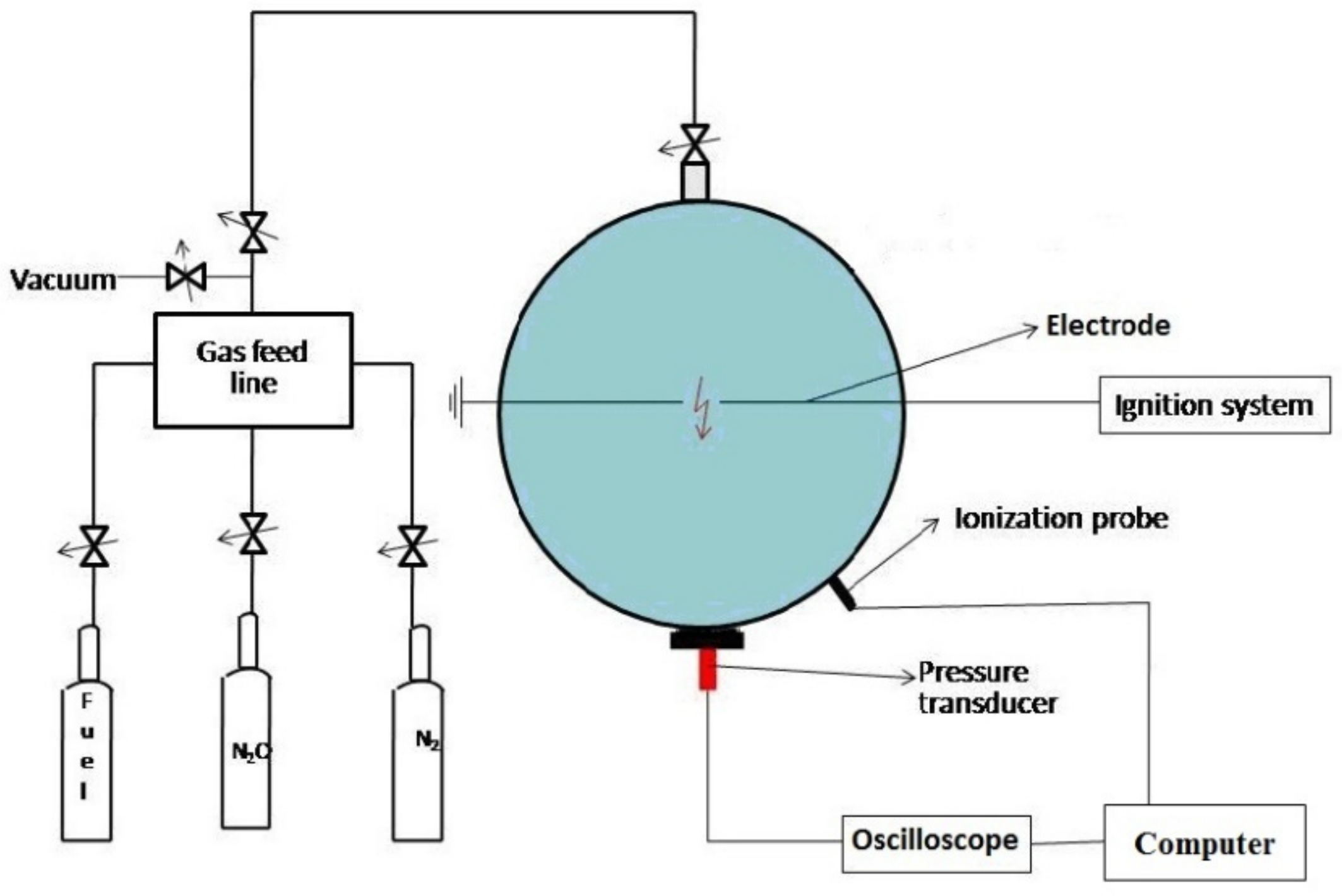

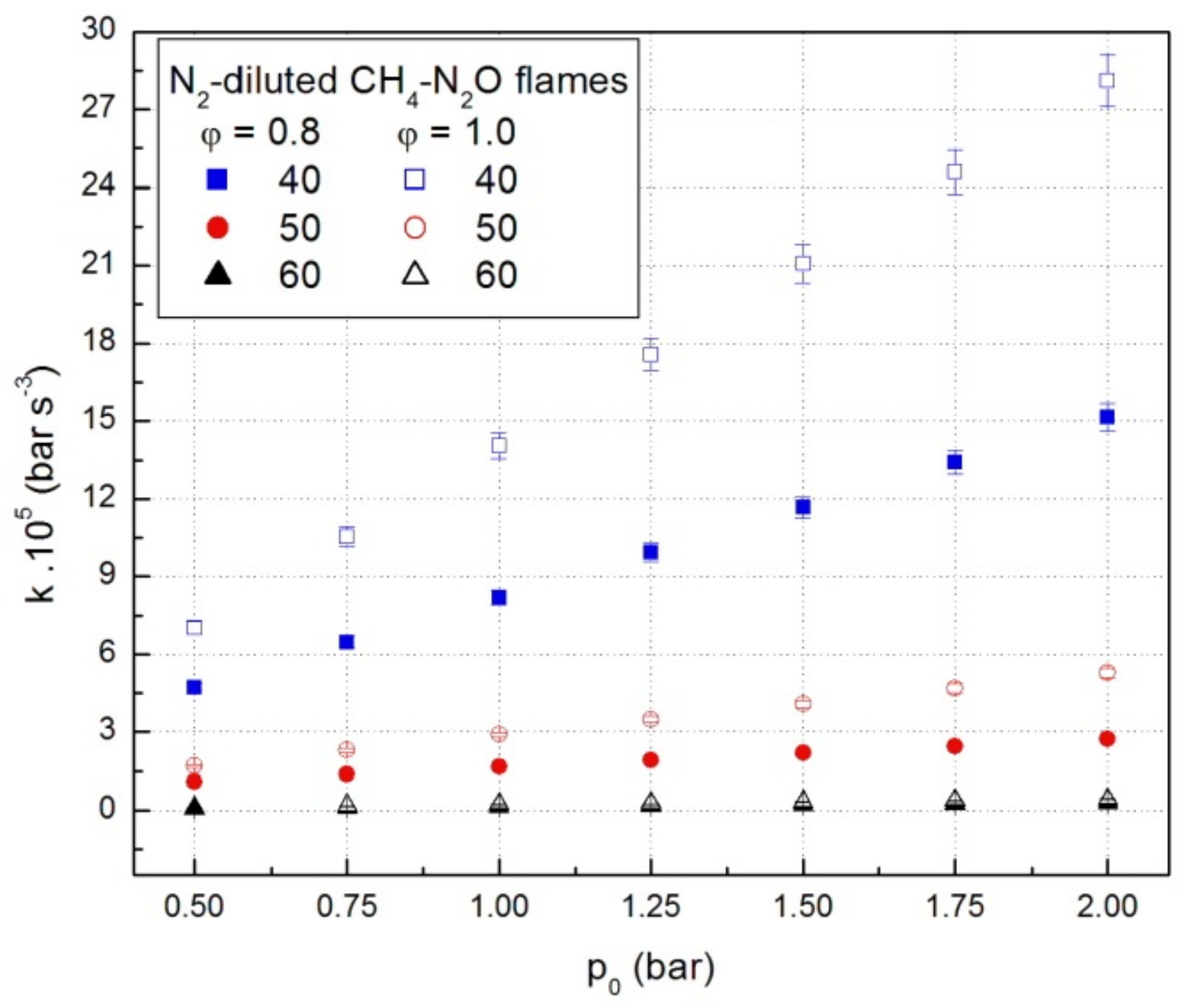
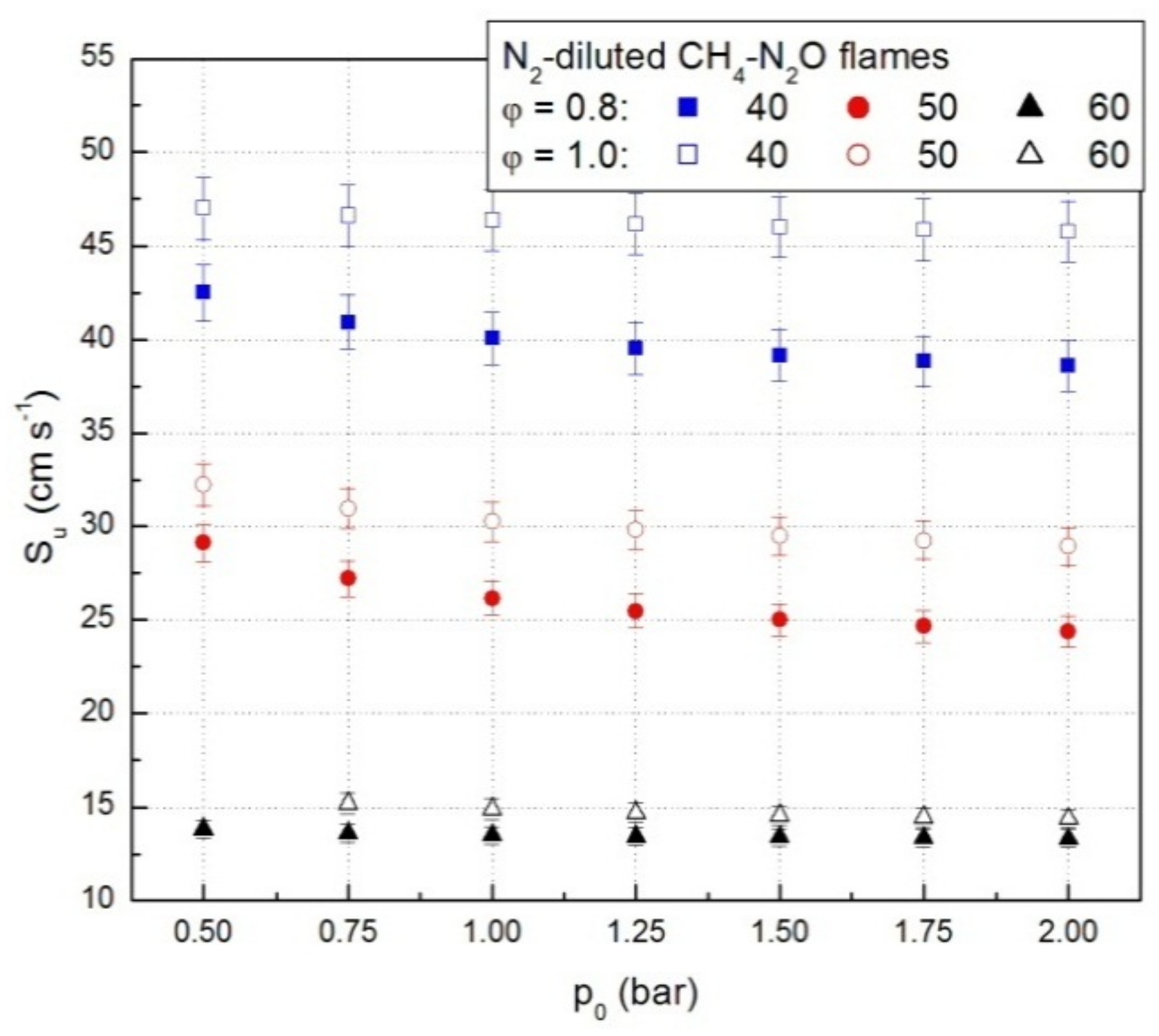

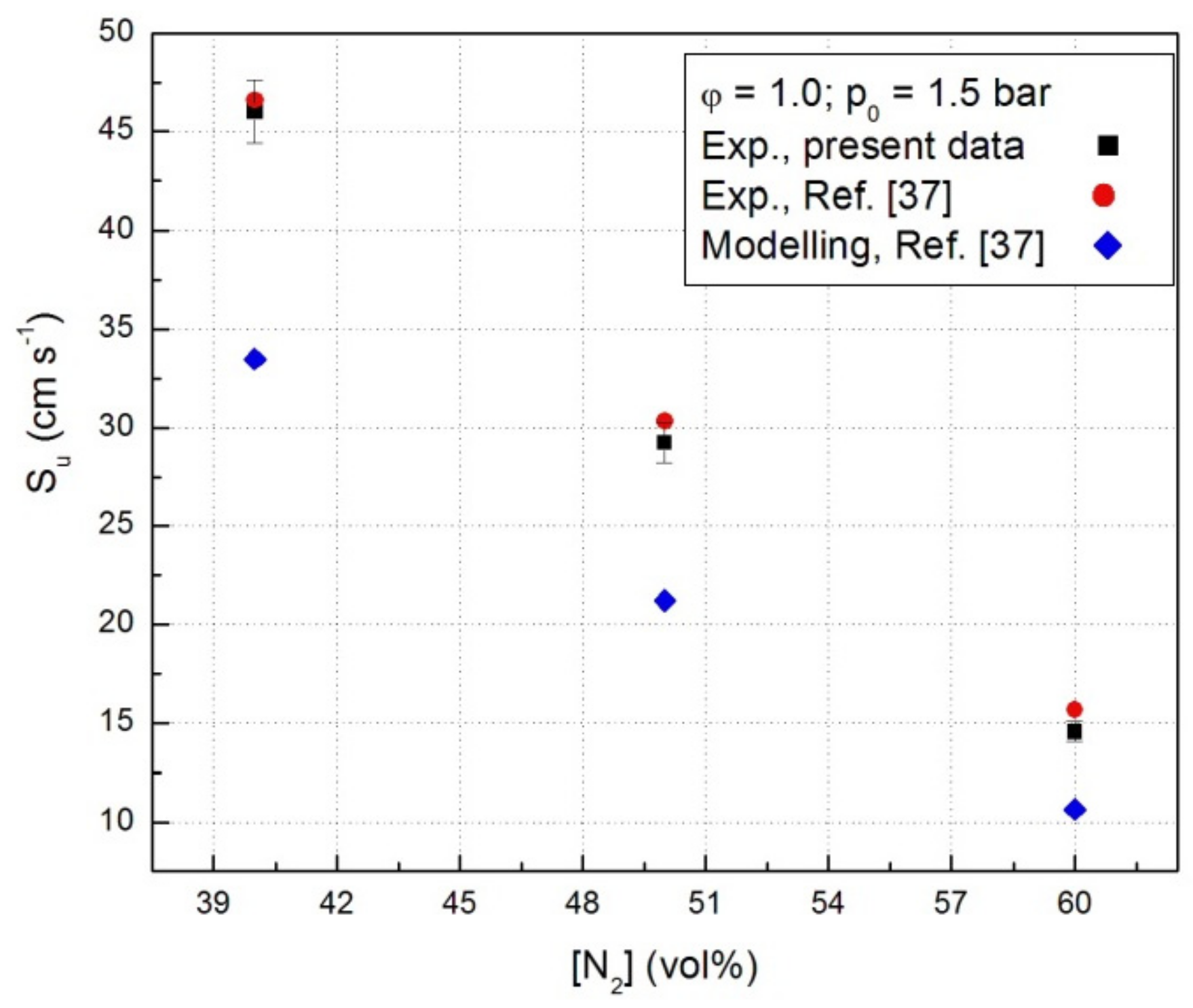
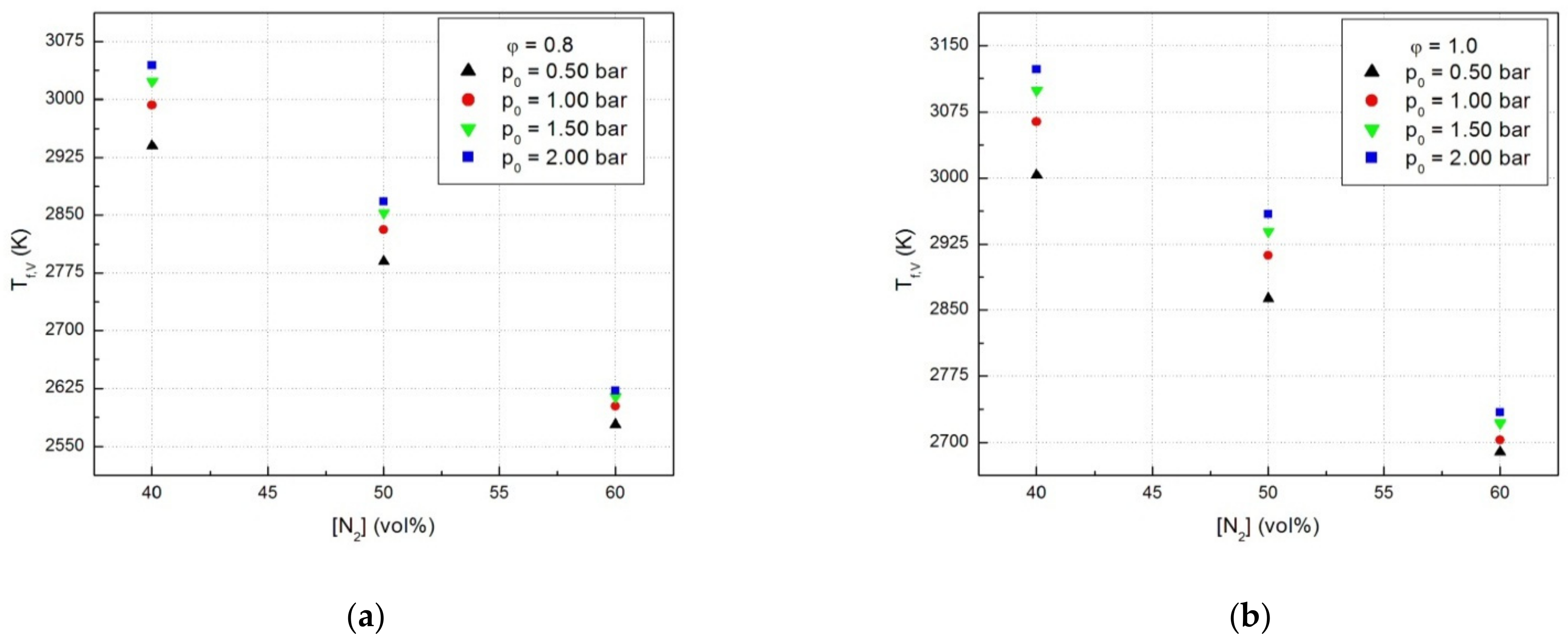

| p0 (bar) | φ = 0.8 | φ = 1.0 | ||||
|---|---|---|---|---|---|---|
| 40 vol% N2 | 50 vol% N2 | 60 vol% N2 | 40 vol% N2 | 50 vol% N2 | 60 vol% N2 | |
| 0.50 | 10.87 | 9.80 | 8.54 | 11.21 | 10.17 | 8.97 |
| 0.75 | 10.97 | 9.85 | 8.56 | 11.29 | 10.23 | 9.01 |
| 1.00 | 10.99 | 9.88 | 8.57 | 11.35 | 10.27 | 9.03 |
| 1.25 | 11.03 | 9.91 | 8.58 | 11.40 | 10.31 | 9.05 |
| 1.50 | 11.05 | 9.92 | 8.58 | 11.44 | 10.33 | 9.06 |
| 1.75 | 11.08 | 9.94 | 8.59 | 11.47 | 10.36 | 9.08 |
| 2.00 | 11.10 | 9.95 | 8.59 | 11.49 | 10.42 | 9.09 |
| Flamm and Mache [49] and Lewis and von Elbe [50] | Babkin et al. [51] | Agrawal [52] |
|---|---|---|
| , equation simplified later as |
| p0 (bar) | Lean (φ = 0.8) CH4-N2O-60%N2 Mixture (the Slowest Studied Mixture) | Stoichiometric CH4-N2O-40%N2 Mixture (the Fastest Studied Mixture) | ||||
|---|---|---|---|---|---|---|
| Equation (3) | Equation Flamm-Mache-Lewis-von Elbe | Equation Babkin-Agrawal | Equation (3) | Equation Flamm-Mache-Lewis-von Elbe | Equation Babkin-Agrawal | |
| 0.50 | 8.54 | 7.81 | 8.62 | 11.21 | 10.17 | 11.12 |
| 0.75 | 8.56 | 7.85 | 8.66 | 11.29 | 10.26 | 11.22 |
| 1.00 | 8.57 | 7.87 | 8.69 | 11.35 | 10.33 | 11.30 |
| 1.25 | 8.58 | 7.89 | 8.71 | 11.40 | 10.38 | 11.35 |
| 1.50 | 8.58 | 7.90 | 8.72 | 11.44 | 10.42 | 11.40 |
| 1.75 | 8.59 | 7.91 | 8.74 | 11.47 | 10.45 | 11.44 |
| 2.00 | 8.59 | 7.94 | 8.75 | 11.49 | 10.47 | 11.47 |
| φ | [N2] (vol%) | -ν | |
|---|---|---|---|
| From Experimental Su (Present Data) | From Computed Su [37] | ||
| 0.8 | 40 | 0.072 ± 0.004 | 0.097 ± 0.010 |
| 50 | 0.134 ± 0.007 | 0.082 ± 0.009 | |
| 60 | 0.027 ± 0.002 | - * | |
| 1.0 | 40 | 0.019 ± 0.001 | 0.101 ± 0.006 |
| 50 | 0.078 ± 0.005 | 0.119 ± 0.009 | |
| 60 | 0.058 ± 0.003 | 0.118 ± 0.008 | |
| Su (cm s−1) | Reference | |
|---|---|---|
| 40% N2 | 50% N2 | |
| 46.4 | 30.3 | Present data |
| 46.5 | 30.1 | [57] |
| φ | [N2] (vol%) | -a |
|---|---|---|
| 0.8 | 40 | 0.054 ± 0.004 |
| 50 | 0.118 ± 0.007 | |
| 60 | 0.021 ± 0.002 | |
| 1.0 | 40 | 0.001 ± 0.00004 |
| 50 | 0.060 ± 0.004 | |
| 60 | 0.047 ± 0.003 |
Publisher’s Note: MDPI stays neutral with regard to jurisdictional claims in published maps and institutional affiliations. |
© 2021 by the authors. Licensee MDPI, Basel, Switzerland. This article is an open access article distributed under the terms and conditions of the Creative Commons Attribution (CC BY) license (https://creativecommons.org/licenses/by/4.0/).
Share and Cite
Mitu, M.; Giurcan, V.; Movileanu, C.; Razus, D.; Oancea, D. Propagation of CH4-N2O-N2 Flames in a Closed Spherical Vessel. Processes 2021, 9, 851. https://doi.org/10.3390/pr9050851
Mitu M, Giurcan V, Movileanu C, Razus D, Oancea D. Propagation of CH4-N2O-N2 Flames in a Closed Spherical Vessel. Processes. 2021; 9(5):851. https://doi.org/10.3390/pr9050851
Chicago/Turabian StyleMitu, Maria, Venera Giurcan, Codina Movileanu, Domnina Razus, and Dumitru Oancea. 2021. "Propagation of CH4-N2O-N2 Flames in a Closed Spherical Vessel" Processes 9, no. 5: 851. https://doi.org/10.3390/pr9050851






